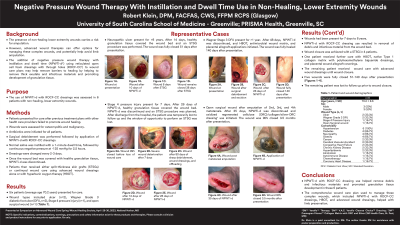Case Series/Study
(CS-084) Negative Pressure Wound Therapy With Instillation and Dwell Time Use in Non-Healing, Lower Extremity Wounds

Introduction: Non-healing lower extremity wounds carry a risk for amputation. However, advanced wound therapies can offer options for wound management, and potentially help avoid limb amputation. Use of negative pressure wound therapy with instillation and dwell time (NPWTi-d*) using reticulated open cell foam dressings with through holes (ROCF-CC†) may help remove barriers to healing by providing hydromechanical removal of infectious materials, devitalized tissue, and wound debris along with promoting granulation tissue development. Use of NPWTi-d with ROCF-CC dressings was assessed in 6 patients with non-healing, lower extremity wounds.
Methods: Wounds were assessed for osteomyelitis and malignancy. Antibiotics were initiated for all patients. Surgical debridement was performed followed by application of NPWTi-d with ROCF-CC. Normal saline was instilled with a 1 minute dwell time, followed by negative pressure at -125 mmHg for 2.5 hours. Dressings were changed every 2-3 days. Once healthy granulation tissue covered the wound bed, NPWTi-d was discontinued. Hyperbaric oxygen therapy (HBOT) was utilized in 2 patients. Wound closure was achieved with split-thickness skin grafts (STSGs) or by secondary intention with use of advanced wound dressings.
Results: Six patients (average age 70.2 years) presented for care. Wound types included ulcer (n=2), Wagner Grade 3 diabetic foot ulcer (n=2), stage 4 pressure injury (n=1), and open surgical wound (n=1). Previous medical history included diabetes, obesity, and hypertension. Wounds were present for 7 days to 8 years. Previous care included debridement and advanced wound dressings. NPWTi-d with ROCF-CC use resulted in granulation tissue development and hydromechanical removal of debris, devitalized tissue, and infectious materials. Four patients received STSGs after NPWTi-d use. One patient underwent further care with native Type I collagen matrix with polyhexamethylene biguanide dressings and placental wound allograft coverings. The remaining patient received advanced wound dressings until wound closure. All wounds were fully closed 51-140 days after presentation.
Discussion: NPWTi-d with ROCF-CC dressing use helped promote granulation tissue development and provided hydromechanical removal of infectious materials, devitalized tissue, and wound debris, in these 6 patients. The comprehensive wound care plan of NPWTi-d with ROCF-CC dressings, HBOT, and advanced wound dressings helped with limb preservation in 3 patients.
Trademarked Items: *3M™ Veraflo™ Therapy; †3M™ V.A.C. Veraflo Cleanse Choice™ Dressing, 3M Health Care, St. Paul, MN
References:
Methods: Wounds were assessed for osteomyelitis and malignancy. Antibiotics were initiated for all patients. Surgical debridement was performed followed by application of NPWTi-d with ROCF-CC. Normal saline was instilled with a 1 minute dwell time, followed by negative pressure at -125 mmHg for 2.5 hours. Dressings were changed every 2-3 days. Once healthy granulation tissue covered the wound bed, NPWTi-d was discontinued. Hyperbaric oxygen therapy (HBOT) was utilized in 2 patients. Wound closure was achieved with split-thickness skin grafts (STSGs) or by secondary intention with use of advanced wound dressings.
Results: Six patients (average age 70.2 years) presented for care. Wound types included ulcer (n=2), Wagner Grade 3 diabetic foot ulcer (n=2), stage 4 pressure injury (n=1), and open surgical wound (n=1). Previous medical history included diabetes, obesity, and hypertension. Wounds were present for 7 days to 8 years. Previous care included debridement and advanced wound dressings. NPWTi-d with ROCF-CC use resulted in granulation tissue development and hydromechanical removal of debris, devitalized tissue, and infectious materials. Four patients received STSGs after NPWTi-d use. One patient underwent further care with native Type I collagen matrix with polyhexamethylene biguanide dressings and placental wound allograft coverings. The remaining patient received advanced wound dressings until wound closure. All wounds were fully closed 51-140 days after presentation.
Discussion: NPWTi-d with ROCF-CC dressing use helped promote granulation tissue development and provided hydromechanical removal of infectious materials, devitalized tissue, and wound debris, in these 6 patients. The comprehensive wound care plan of NPWTi-d with ROCF-CC dressings, HBOT, and advanced wound dressings helped with limb preservation in 3 patients.
Trademarked Items: *3M™ Veraflo™ Therapy; †3M™ V.A.C. Veraflo Cleanse Choice™ Dressing, 3M Health Care, St. Paul, MN
References:

.png)
